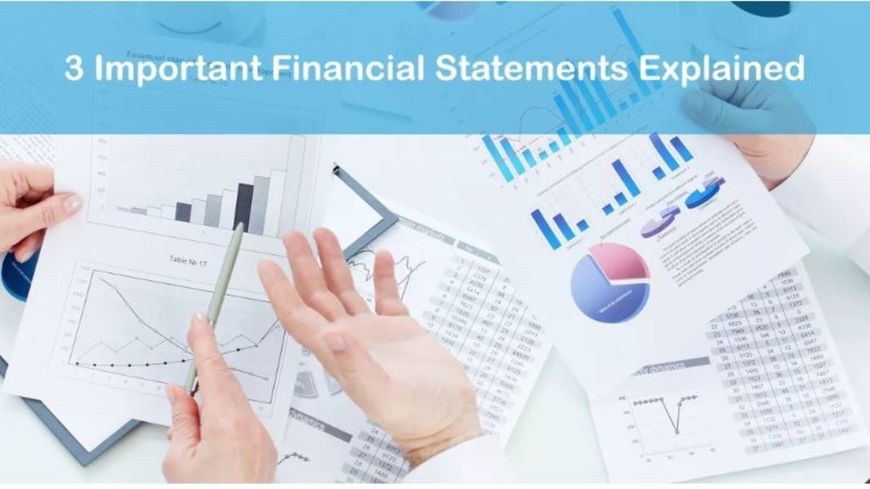3 Important Financial Statements Every Business Owner Should Know
Small businesses must be well informed to survive in a competitive environment and one of the vital competency they must develop is to read and understand important financial statements. Understanding essential financial statements such as ‘Trial Balance’, ‘Balance Sheet’, and ‘Profit and Loss’ statements is paramount as these are very important reports for small businesses to ensure their competitiveness in the market.
Running a business without understanding these financial reports is like driving a car without a dashboard. Let’s look into each of these financial reports in detail..
Businesses engaged in financial activities need constant information on a variety of parameters such as market demand, market share, price, competitive activity, cost of production, investment, cost of capital, and statutory levies. Of these, one of the most vital one is financial information such as revenues, costs, capital, salaries, loans and investments. If you take an example of a household, information on items such as salary earned by the principal wage earner, expenses incurred on running the household, school fees and price of vegetables would be some of the information required on a regular basis and this would constitute financial information.
One of the methods of collecting and storing financial information is the double entry method where for every amount of money transacted there will be a debit entry in one account and a credit entry in another account. All the accounts will either have a credit balance or a debit balance.
In order to ensure that the data recorded is correctly done and stored, accountants use a tool known as the trial balance. The trial balance will allow the accountant to prepare the information that can later be utilised for generating important financial statements such as the balance sheet and the profit and loss statement (also known as the income statement).
These two statements are considered to be the most important financial statements for a variety of people interested in any company or organisation. For instance, one could be an investor wanting to invest in the company. One could be a supplier wanting to supply goods and services. One could be a lender who has leant money to the company and wants to know if the company is doing well enough to repay the loan taken.
The balance sheet is the financial state of affairs of a company on any given day, usually the last day of the financial year (typically March 31 each year in case of India). It gives an accurate picture of the company on that particular day in financial terms represented by assets, liabilities and equity. In the household example, the family can take stock of the year gone by and plan to balance the accounts either by borrowing if there is a shortage or by saving if there is an excess.
The profit and loss statement is the financial state of affairs of a company for a given period usually a financial year encapsulated in the form of either a profit or loss for the company. Typically, companies make a profit and loss statement for a quarter or even a month to help the company assess its performance vis-à-vis objectives set. In the household example, the family tends to make a profit and loss statement every month coinciding with the receipt of salary for the month.
Based on the important financial statements of the company people can come to conclusions about the financial health of the company and take steps to engage with that company. Similarly, these statements are among the more important reports for small businesses to project themselves in the market.
What is Trial Balance
In an accounting system based on the double entry method, any expenses incurred would be posted as a debit in one account and a credit in another account. Similarly, any money received will also receive the same treatment. Once the period is over and all entries made, a trial balance will be prepared. This will be the summation of all general ledger accounts.
At the end of the period (one year) for which the trial balance is generated, all accounts will show a credit balance or a debit balance depending on the number of transactions posted to each account. When the balances are listed out it will indicate whether the total of all debits is equal to the total of all credits. If they don’t tally then an investigation could reveal an error and the same can be rectified (that is why it is called a trial balance). The trial balance will also help tracing any arithmetical errors or wrong entries.
After rectifying the errors in such a way that the credits and debits are equal the trial balance will be used to prepare important financial statements, more specifically the balance sheet and the profit and loss statement.
The trial balance is an internal document and it is meant only for company officials and internal auditors.
Here is a trial balance example generated from ProfitBooks.
What Is A Balance Sheet
The balance sheet gives the financial state of affairs of a company as on a particular day in relation to the liabilities, assets and capital belonging to a company. Just as a photograph captures a moment the balance sheet captures the performance of the company as on a certain day.
Lets look at the various components of a balance sheet.
Liabilities
Typically, the liabilities side of the balance sheet includes items such as share capital, reserves and surplus, secured and unsecured loans and current liabilities and provisions.
Capital
For instance, a manufacturing company would need capital to buy equipment that produces goods. It would need funds to pay salaries for manpower. The funds would come from the owners and this is referred to as capital (equity).
Secured and Unsecured Loans
If their capital is not sufficient then they would borrow from lending agencies or seek investors. These borrowings could be in the form of secured loans and unsecured loans. When loans such as debentures or bank loans are given against the asset of a company they are known as secured loans. When loans or advances are given without security of company’s asset they are known as unsecured loans.
Current Liabilities
Current liabilities are monies owed by the company to suppliers, vendors, contractors or consultants which need to be paid within the financial year and are usually paid out of current assets of the company. These include among others sundry creditors, expenses accrued and advance payments.
Reserves and surplus
Reserves and surplus are profits that are retained by the company without distributing it to owners of equity.
Provisions
Provisions are undetermined liabilities such as dividends, taxes and contingencies incurred in the financial year which are provided for to be paid at a later date.
Assets
The assets side of the balance sheet includes items such as fixed assets, investments, current assets, miscellaneous expenses and debit balance of profit and loss account.
Fixed Assets
Fixed assets are physical assets (valuable items owned by the company) such as land and building, equipment, furniture and fittings and transport vehicles, cash, stocks of produced goods and money to be received which it uses to manufacture products or render services and earn revenue by selling the products or services.
Investments
Investments in real estate, bonds and stocks that the company plans to hold for more than a year are treated as assets on the balance sheet.
Current Assets
Current assets are short-term assets that can be converted into cash within the financial year. These include stocks, raw materials held, work in progress and accounts receivable (which are generally credit sale).
The balance sheet (as the name suggests) should balance out assets and liabilities sides of the financial statement.
The relationship between the three is a simple equation that can be written as follows:
Owner’s equity = Assets – Liabilities
Profit and Loss Statement
Since a company is run with specific objectives such as to earn profits it is important that its operations for a year are encapsulated into a statement known as the income statement or a profit and loss statement. Lets see how to prepare a Profit and Loss statement.
Profit or Loss
Profits can be made if revenues exceed costs or expenses. Conversely, if costs or expenses exceed revenues then losses are made. Therefore, the profit and loss statement records the performance of the company in the whole year and tells whether the company is financially healthy or not.
The profit and loss statement can be explained with the following equation:
Profits = Revenue – CostsRevenues
In the above equation, revenues are typically sales revenue realised for products sold or services rendered.
Costs
Costs are bifurcated into variable expenses and fixed expenses. Variable expenses depend upon the sales of a product or service, rising with rise in sales or decreasing with decrease in sales.
Fixed expenses on the other hand stay fixed irrespective of sales achieved. For instance, rent for the office building, salaries for office staff and insurance expenses fall under fixed expenses.
Gross Profit
Gross profit is obtained by subtracting operating expenses from operating revenue.
Operating Income
Operating income is obtained by subtracting overhead from gross profit.
From the above example image, it is clear that the Company has made a profit and the performance of the company is considered good. However, if there was no profit but a loss then performance of the company would be considered as not good.
From the foregoing it is seen that financial information is very vital for a company to perform well in the business. Financial information is captured and stored in an accounting system that follows a double entry method where a transaction enters twice, once on the credit side and once on the debit side. Based on the information captured and stored trial balance is prepared which helps to ensure that data is captured and posted accurately. Subsequently, profit and loss statement and balance sheet are generated, which are important financial statements from which the health of a company can be gauged.
By learning to read these essential financial statements a host of information can be gathered by different stakeholders of the company which may include owners, investors, lenders, lay public, financial analysts and other interested parties. These are important reports for small business to generate so that it can showcase its performance to its stakeholders.
Financial statements help the managers of the company to understand their company better. Typically, managers can prepare these 3 financial statements for each month or quarter so as to help them take corrective measures, if needed. Similarly, these important reports for small business would help them to approach lenders or if they have already borrowed to tell the lenders of their performance.
How ProfitBooks Can Help
ProfitBooks is an easy to use accounting software designed for non-accountants. Business owners can create beautiful invoices, record expenses and track inventory easily. ProfitBooks automatically generates taxation reports and important financial statements such as Balance sheet, Trial Balance & Profit and Loss.
You can try ProfitBooks free for 2 weeks. Signing up takes just few minutes.
This article originally appeared here.

.jpg)



